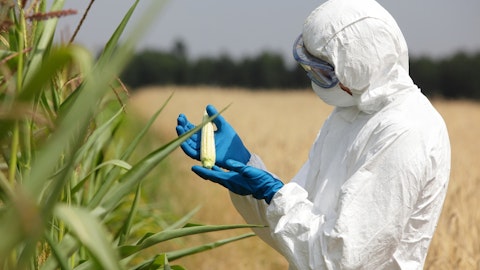Operator: Our next question comes from Reni Benjamin from Citizens JMP.
Reni Benjamin: Congratulations on a great quarter and even more impressive guide. Can you talk a little bit about the trajectory in Europe and maybe what contribution of the guidance is coming from Europe? I know you mentioned in the prepared remarks the launch will start in Germany, but can you maybe just talk us through the cadence of how the countries come online and who’s doing the actual selling? And just as a follow up, you’ve talked now about the $2 billion peak revenues. How do you think about how long it might take to get to peak revenues?
Kate Haviland: Christy, do you want to talk about European peak actually?
Christy Rossi: Sure. So we were pleased to see the European approval come through before the end of last year. As I think everyone knows and even more pleased to see that we saw ISM patients being treated in Germany even before the holidays, which was great to see. So we’re out of the gates in Europe and ISM. Germany is really going to be the primary market that’s driving ISM this year, due to the cadence of pricing and reimbursement. So other markets will start to come online, but I would expect that more towards kind of end of this year into next year. I think the important thing is if we’re thinking about from a revenue perspective, certainly our guide does encompass international and that’s yet another variable actually, we think about sort of the guidance range as that launch gets underway.
My general expectation is that if you look at the percent of revenue that the international business contributed to AYVAKIT, say in 2023, it’s probably going to be roughly in the same range as the U.S. continues to grow very robustly. So, 10-ish percent plus or minus is probably not a bad assumption there to think about Europe. In terms of the peak, I think again, Kate mentioned, we’re on a very clear trajectory that I think looks a lot like other rare disease launches, the time to peak in those launches, you know, it varies, right? These are never markets that are sort of up to saturation within two or three years, and then flattening. I expect AYVAKIT revenue to drive growth for Blueprint for several years to come. One thing that I think is often interesting about time to peak is that there is often a positive relationship between time to peak and what the peak is.
So, we just talked about our view of the peak kind of coming up to $2 billion. If you look at markets like HAE, if you look at even Jakafi or Soliris, those drugs have continued to grow and the peak opportunity has also continued to grow because the market grows underneath the drug launch. And so, we’ll see what happens. It wouldn’t surprise me if our view of the peak continues to evolve as we move through this launch.
Operator: Our next question comes from Michael Schmidt from Guggenheim.
Michael Schmidt: I had one on BLU-808. As we sort of head towards AAAAI next week, how do you think about the overall development opportunity for this oral wild-type KIT inhibitor? And talk a bit about how you see potential for differentiation from biologics that are in development for a wild-type kit?
Kate Haviland: We’re really excited about BLU-808. Suad, do you want to talk a little bit more about that?
Suad Namouni: So a lot our question first, I have to say I’m very happy today to see a proof-of-concept having been achieved in inhibit — by inhibiting wild-type KIT with a strategy using monoclonal antibodies. So the POC is there. Now, BLU-808 is a small molecule TK inhibitor that is highly wild-type KIT, very selective, which will have a promise and safety profile as we run the SAB mAb studies, I believe. It is very flexible way to administer a drug and it will be very simple to give compared to all the strategies. The most important thing that in my opinion will be a key inflection pointing for us in BLU-808, is the safety and pharmacology data that we will gather from the SAB mAb. After that, I think the POC of wild-type could be the superior strategy of inhibition in CSU has already been shown in some Phase 2 data.
Beyond CSU or chronic spontaneous urticaria, there is cold and used urticaria as we all know, but overall mast cell, as I mentioned in my earlier remarks has been really underappreciated target in Type 2 inflammation. And now that we started knowing this in our industry, IBD, the opportunity to leverage blow it weight and wild-type KIT inhibition overall in the number of inflammatory disorders such as Type 2 asthma or MCAS and others, will be very important. I think patients will — at the end of the day, like an oral agent that we can die up and down depending on the need for the diseases.
Becker Hewes : I just wanted to add one thing. This is Becker. I get the question a lot about how a wild-type KIT inhibitor, what might compare with what is currently being developed. And I think one thing to remember is we’re talking about a very wide spectrum of disease with different manifestations and different tissues and different levels of severity, and using a blunt instrument like an antibody that might eliminate a number of mast cells isn’t where you want to go with a lot of these diseases. And so we think that at tuneable solution that is — we can titrate to what each patient or patient population needs is the right thing in this population or in these diseases. The other thing to remember is that most of these approach, whether it’s BTK or antibodies, don’t directly address the true driver of the mast cell, which is KIT.
BTK inhibits activation and degranulation but really doesn’t address the biology of the mast cells and even the antibodies they’re active in asthma are really an orthogonal approach to the disease methodology. So really KIT is the Achilles heel of these diseases.
Operator: Our next question today comes from Derek Archila from Wells Fargo.
Derek Archila : Just two questions from us. You talked about kind of an increasing rate of diagnosis for ISM. I guess I’m just curious, do you think current estimates might be still slow for the number of patients out there? And I guess, what inning do you think we are in terms of the increasing diagnosis rate? And then just as a follow up, any additional kind of quantitative color on the current discontinuation rate you’re seeing?
Kate Haviland : Maybe just starting with the epidemiology. I mean, we updated epidemiology at JP Morgan. We’ve seen really nice growth in the diagnosis of SM that is predominantly ISM, right. Because advanced SM patients are — have a smaller or less intense diagnostic odyssey just given the manifestations of that disease. And we’re in very early innings on understanding the size of this market and we anticipate it’ll continue to grow very substantially over the next set of years. Just as Christy talked about what we’ve seen in other rare disease launches. So anyone want to talk a bit about the durability we’re seeing and how that becomes such a big part of the kind of future value prospect of AYVAKIT?
Christy Rossi: Yes, sure. We have been really pleased to see the clinical profile of AYVAKIT really playing out positively in terms of real world experience. Compliance has been really high and while we’re really early in the launch, but very low discontinuation rates which bode well for chronic durations of therapy with AYVAKIT. And at this point in the launch, as we continue to add more patients that duration and the cumulative impact of adding more patients and more patients staying on therapy is going to be a substantial contributor to the revenue growth going forward.
Operator: Our next question comes from Laura Prendergast from Raymond James.
Laura Prendergast : Congrats on the big day today. Very exciting to see. Just two questions from me. First, what is driving these new patients starts? Do you think it’s more so from the patient awareness side or education from providers during routine visits? And then my second question is as you guys think about the CDK2 partnerships, is this focusing on just partnering the BLU-222 asset or are you more so thinking about partnering the whole CDK2 franchise in the next gen and the degrader you guys brought up at JP Morgan?
Kate Haviland : Philina, do you want to talk a little bit about how we see the drivers new patients starts, then Christy, we’ll hand it over to you to talk about this development around CDK2.
Philina Lee: We entered the launch already with strong awareness among our targeted hemoc and AI. Initially the drivers, obviously some of the hemocs were coming in with experience with AYVAKIT from advanced SM. That was what we shared in some of our very earliest adoptions. But what’s honestly been really exciting to see is an expansion in the breadth of new prescribing, in hematology oncology as well. They are motivated, they are so much more excited about ISM and the opportunity and the need here as well as an increasing proportion of allergy immunology who are prescribing. Significant growth to date there, significant headroom to grow, as we’ve said. To date, the majority of that growth has been driven by provider engagement.
We’ve talked about how out of the gate we have made available a lot of really patient facing, initiatives and JP Morgan, we shared that we almost doubled patient awareness of AYVAKIT, which activates them to speak to their provider about it. But I would say with the patient activation that’s early days and that’s even more headroom to grow on that front. We know patients are a critical stakeholder in this type of chronic disease where they’re a key part of that shared decision making with their providers. And so this year, we’re really embarking on deeper direct to patient initiatives to promote, increase the awareness of AYVAKIT and really encourage them to seek options that can give them better disease control. We’re excited to share more about that.



